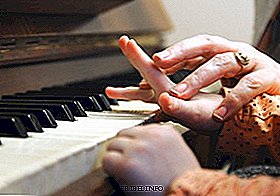 A new student has come to your class. The first line - the entrance exam - they successfully overcome. Now it's your turn to get to know this baby. What is he like? Talented, "middling" or not at all able to work? What is the lottery ticket you got?
A new student has come to your class. The first line - the entrance exam - they successfully overcome. Now it's your turn to get to know this baby. What is he like? Talented, "middling" or not at all able to work? What is the lottery ticket you got?
Teaching children to play the piano is a difficult and responsible process, especially in the initial period. Analysis of the natural potential of the child will help to plan future work properly taking into account strengths and weaknesses.
The selection committee has already evaluated it according to the “hearing-rhythm-memory” scheme. And what if these points are so-so? Will this mean the futility of your teaching efforts in learning to play the piano? Fortunately, no!
Not afraid of a bear
In the sense of the one that stepped on the ear.
- Firstly, if a child is unable to purely introduce a melody, this is not the sentence “No hearing!”. It only means that there is no connection between the inner ear and the voice.
- Secondly, the piano is not a violin, where auditory control is a necessary condition for quality performance. Dirty singing intonation does not interfere with the pianist's game, because he was given a miracle instrument with a ready-made system.
- Third, the ear can be developed, even to the absolute. Immersion in the world of sounds - the selection of the ear, singing in the school choir, lessons solfeggio, and even more classes by special methods, such as D. Ogorodnov - very much contributes to this.
Walking together is fun ...
The shaky metrhythmic feeling is a little more difficult to correct. Call "hear a strong share", "feel that the eighths need to play faster" will be an abstraction for the child. Let the student find the meter and the rhythm in himself, in his movements.
Step. Go along with the music. The uniformity of steps creates a metric ordering. Measuring musical time through walking is the basis of N. Berger’s “First - Rhythm” manual, which can be recommended to those who have encountered rhythmic difficulties.
Pianist palmistry
When teaching children to play the piano, the physiological structure of the pianistic apparatus plays an important role. Carefully consider the hands of the baby, assessing how it will develop technically. The proposition that only owners of long and thin fingers will become virtuosos is a myth. On the contrary, length, especially when combined with muscular weakness and sagging phalanges, is more likely an impediment to fluency. But the short-fingered strong “kornelasty” quite confidently flit in the scales.
Objective defects that cannot be changed:
- small (less than an octave) hand;
- massive stiff thumb.
Other deficiencies are corrected by gymnastics according to the system of J. Gata or A. Schmidt-Shklovskaya.
Can I, do I want ...
Assessing the ear, rhythm, hands, the teacher proclaims: "Suitable for classes." But do you agree with them?
One student, like Masha from the cartoon, happily exclaims: "And how did I live without the piano? And how did I live without music?". Another was brought to school by ambitious parents who dream of the triumph of a talented child. And the child in class obediently nods, is silent and seems to be bored. Think: which of them will develop faster? Often under-gratitude is compensated by interest and hard work, and talent fades away without revealing because of laziness and passivity.
Your first joint year will fly by unnoticed, because the initial teaching of children to play the piano takes place in an entertaining form. The realization that execution is work will come later. In the meantime, develop, carry away, fall in love with your "middling" in music. And then his path will be joyful, without stress, tears and disappointments.

Leave Your Comment